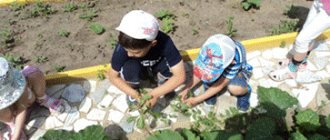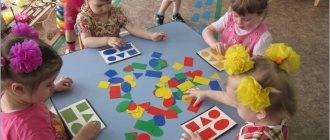In order for a child to grow up independent, it is very important to develop his self-care skills in a timely manner. This includes the ability to drink and eat independently, hygiene skills, cleaning toys and much more. At what age can you start teaching your child to take care of himself? What skills should a child learn first? How to properly develop self-care skills? What to do if a child resists independence? We will talk about this in today's article.
How to develop independence in a child: basic principles
Despite their small age, children can do a lot on their own if they are given the opportunity. But in order to develop self-service skills in a child, you will have to be patient. At first, when your baby is just beginning to master a skill, be prepared for the fact that actions that were previously performed easily and quickly with your help will take much more time. And a child who learns to use a spoon on his own will most likely get himself and everything around him dirty. But, believe me, the effort and nerves expended will definitely pay off for you a hundredfold. Gradually, the baby will do better and better, and, in the end, he will completely refuse your help. So, if you want to develop independence in your child, adhere to the following rules:
- Allow your baby to act independently;
- Praise your child for his desire to do something himself;
- Don't scold him if he does something for a long time and clumsily;
- If your child asks for help, do not refuse him.
“Help me do it myself” is a fundamental principle of the Maria Montessori system. And our task, as adults, is to create a space for the baby that meets his needs.
In order for a child to have the opportunity to express himself independently, appropriate conditions must be created at home. Things that do not pose a danger to the baby should be freely available. There are several types of independent activity of a child, the implementation of which adults can ensure through the organization of space:
- Quenching thirst (a jug and a glass of water should be freely available to the baby);
- Cleaning (let the baby have his own broom, dustpan, bucket, brush, rag, sponge);
- Caring for plants (for this you only need a small watering can and a spray bottle);
- Changing clothes (it is advisable that the baby has access to some of his clothes and shoes);
- Maintaining hygiene (so that the child can wash his hands or wash himself, place a special attack under the sink);
- Setting the table (the child needs to know where his dishes are kept);
- Cooking (your baby will be happy to help you prepare food);
Remember that by organizing a developmental space for your baby, you open up many opportunities for him to demonstrate independence, but do not oblige him to do anything.
MAGAZINE Preschooler.RF
Formation of self-care skills in children 2-3 years old.Self-care is the beginning of the labor education of a preschooler. Mastering self-care skills (the ability to dress and undress, take care of yourself, use the toilet, eat independently, wash yourself, etc.) directly affects the child’s self-esteem and is an important step towards his independence. Unfortunately, recently more and more parents are overprotective of their children. Some parents often do everything for their children (clothing, feeding), believing that their child is still very small. This leads to the child not developing independence in self-care skills. In connection with the above, the problem of developing self-service skills in children of primary preschool age arises.
For a child of the third year of life, self-care includes mastering the following skills:
- eating (eating with a spoon, drinking from a cup)
- undressing and dressing (taking off and putting on panties, tights, shorts, trousers or a skirt, hat, mittens, putting on and taking off shoes)
- body hygiene (wash hands and face, dry them with a towel, use a handkerchief and napkin)
- neatness (use the potty).
These skills are formed under the influence of upbringing at a certain level of development of certain psychophysical capabilities in the child. These include:
- gross motor skills (ability to sit, stand, walk, go up and down stairs)
- fine motor skills (the ability to push, pull, turn over an object, hold and release it, play with water, put objects into a hole in a box, pick up small objects with two fingers, perform simple finger games)
- visual-auditory attention (the ability to look and come when called, listen to fairy tales, answer questions in an accessible way)
- thinking (the ability to recognize objects, follow simple instructions, assignments; the ability to imitate, i.e. imitate the actions of adults).
It is with the development of these simple skills that the path to mastering more important, in practical terms, self-service skills begins. Therefore, we must start with them. As a rule, by the age of two years, general motor skills in children are quite well developed, but the development of fine motor skills is a complex process that requires gradual development. To successfully develop self-care skills, indirect training of hands and the development of their fine motor skills are necessary. This can be done in specially organized classes, in games or simply in everyday situations.
Here are several options for games and activities for children that can be organized to develop the baby’s hands:
- invite the child to transfer balls, nuts, beans or beads from one bowl to another, first with his hand (each separately), then with a spoon (starting with a large table or wooden one, then move on to a tea spoon), then with tweezers
- let him unscrew and screw caps on plastic bottles and jars
- let him push objects into the holes, for example, coins into a piggy bank
- string objects on a cord, for example, beads for mother and grandmother from large pasta with holes
- pour water with a pipette or syringe, for example, a toy is sick, you need to give it some medicine
- launch a boat in a basin of water, or in the bathtub
- create a wave with your hands, nailing the boat to one edge, then to the other
- catch soap in water.
- play story games with your baby “Doll Masha goes to the store” , using wallets and bags with different types of fasteners: Velcro, zipper, button, button, ties; “We wash the doll’s dress” (we hang up the doll’s clothes and fasten them with clothespins), “The bunny wakes up, the bunny washes itself” (we put on the doll’s clothes and imitate the washing process).
In a preschool institution, self-service in young children can be developed using various methods: verbal, visual, practical. Next we will reveal these methods.
Verbal method, general reminder technique. It must be used to perform any task at a time when certain self-service skills have already been formed. This method requires special control over the activities of children and every change in it. It is important not only to train children of early preschool age in performing self-care actions, but also to check the quality of the action performed. It is also important to teach children to help each other: so that in a preschool institution they work not only to satisfy their personal needs for cleanliness and order, but also willingly help each other.
Another verbal method is the use of fiction, which stimulates children’s activity in mastering self-service skills. In order to make children want to show independence in dressing and washing, it is necessary to use children's songs, poems, and nursery rhymes. To familiarize children with the necessary cultural and hygienic skills, it is necessary to use special classes, looking at plot pictures, reading works of art, folklore. The following works of art have a positive impact on children in developing self-service skills: A. Barto “The Dirty Girl” , K. Chukovsky “Moidodyr” , “Fedorino’s Grief” , V. Mayakovsky “What is Good and What is Bad” , Kaputikyan “Who “He’ll finish his drink sooner” , Z. Aleksandrova “What did you put in place” , “Stomper” , I. Muraveyka “I myself” , stories by L. Voronkova “Masha the Confused One” , nursery rhymes: “Water, water...” , etc.
Nursery rhymes play a significant role in developing self-service skills. In order for young children to have a desire to wash themselves, and also to make this process easy and enjoyable for them, we learn nursery rhymes in accordance with the actions performed, calling the child’s name: “ Okay, okay, wash your little hands with soap.” at Masha's. Clean Machine palms, here’s bread and spoons for you!” .
When using the visual method, a step-by-step demonstration and detailed explanation of the correct execution of a particular action is used. It promotes the effectiveness of teaching self-service skills, as it teaches children accuracy and diligence in performing certain actions. When learning to dress and wash, it is important to strictly follow a certain method and algorithm of targeted actions. A particularly effective technique is to show dramatizations using tabletop theater toys, bibabo dolls, for example: “How the Bunny washes himself , “The Hedgehog teaches the squirrel to eat beautifully and correctly ,” as well as playing techniques with dolls. So, for example, when learning to undress independently, we undress the doll Olya, who went for a walk with the children, and accompany our actions with a detailed description of the sequence of actions performed (first unfasten buttons, zippers, fasteners on shoes), carefully fold the clothes on the shelf. To consolidate the skill, you can also effectively apply an algorithm for the process of dressing and undressing with pictures of the sequence (dressing, undressing, which are posted in the reception area). At the same time, children repeat and remember the names of parts of clothing. This technique always evokes positive emotions in children. This allows all children to be held to the same standards when performing a similar self-care task, and also promotes the rapid development of a lasting skill.
A practical method of action (exercises) is necessary for mastering self-service skills, as they are not formed immediately, but over a certain period of time. In order to teach children how to properly and efficiently wash, dress, etc., it is important that they learn how to do this. In order to consolidate the learned method of action, it is necessary to constantly train students, offering them various options for using it. After some time, the necessary skill will be successfully developed.
A play technique, which also refers to a practical method, helps to increase children’s interest in independence in using toys, organizing games with them (dressing a doll, undressing it, putting it to bed, feeding it).
Developing self-care skills in young children is a long process that requires a lot of patience and time not only from educators, but also from parents. In recent years, many parents do not attach serious importance to instilling independence in their children and, considering them too young, try to do everything for them themselves. Others, understanding the importance of fostering independence in a child’s development, still show impatience and do for the child what he can handle himself. This happens at such moments: in the morning parents rush to work, and in the evening they are tired, and the slowness of their children irritates them. Only in some families do young parents who live alone, work and also study, teach young children to work on self-care.
The speed of formation of self-care skills depends on the individual characteristics of the child, the type of nervous system (choleric, phlegmatic, sanguine and melancholic), on the speed of memorization, on the family attitude towards cleanliness and tidiness, since it is the example of parents and loved ones that is most important for the baby.
And most importantly, you must not forget to give a positive assessment of the child’s actions! Use different ways to tell your child that he is doing well: “Very good! Well done! Great! You did it! Hooray! Amazing! You did it! Great! Right! I am so glad!" This could be a kind word or touch, small homemade gifts (made of paper, thread, plasticine, crafts made from natural materials), and sometimes a sweet treat. Any praise has a positive effect on achieving a good result.
| Next > |
How to teach a child to use a spoon?
One of the first self-care skills that a baby can learn is the ability to use a spoon independently. At about the age of 1 year, the child develops a desire to perform instrumental actions (for example, digging sand with a shovel). This moment is perfect for giving your baby a spoon. Here are some tips on how to teach your child to feed himself:
- Eat with your baby. Sit next to her and show her how to use a spoon. Soon the child will begin to repeat after you.
- Surely, at first the baby will not be able to bring the spoon to his mouth. If the child does not mind, hold the baby's hand and guide it.
- To make it easier for your child, use a special curved baby spoon.
- If your baby tries to hold a spoon, but quickly loses interest, don’t insist. Over time, the number of “independent spoons” will increase.
The main conditions for successfully teaching a child to use a spoon are a positive attitude and patience of parents. You should not put pressure on your child if he refuses to eat on his own. The time will come when he himself will try to take the spoon from you.
Do we even need a nursery?
Each parent has the right to independently decide when to take their child to kindergarten and whether to do it in principle.
Early adaptation is much more difficult; failure to understand the seriousness of what is happening can lead to all sorts of negative consequences .
On the other hand, early attendance at kindergarten, if all recommendations are strictly followed, will help ease the further transition to school and make the child more independent. In kindergarten, all conditions are created for full, comprehensive development, similar indicators of which are difficult to achieve at home.
Young children naturally cause particular concern among parents, so many of them simply refuse to attend nurseries in order to maintain mental well-being.
If at least one of the parents has the opportunity to pay attention to the child at home - organize useful leisure time, instill self-care skills, engage in training and education, provide conditions for the child to interact with peers, refusal from the nursery may be justified.
In all other cases, visiting kindergarten is a useful, vital experience that every child needs.
Teaching a child to wash his hands independently
After a year, you can teach your baby to wash his hands on his own. Children usually love water procedures, so this skill is formed quite quickly. Show your child how to soap his hands and how to rinse them. If necessary, help your child do this more carefully. Let the baby have his own towel available so he can dry his hands.
How to teach your child to clean up after themselves?
The age from 2 to 4 years is the ideal time to teach a child to be neat and tidy. During this period, children are usually real conservatives: children's need for constancy and predictability in the world becomes more acute than ever.
Early teaching of order to a child will help to avoid problems with the development of independence and responsibility in older preschool age.
Introduce a rule: take a new toy only after the child puts away the things with which he has already played enough. Cleaning should not be a punishment for the baby; let it become a natural end to the game for him. Don't force your baby to clean if he's naughty. Offer your help or even do it for him. Sooner or later, the baby will definitely begin to imitate you.



